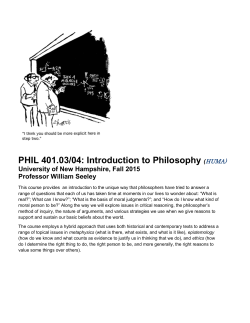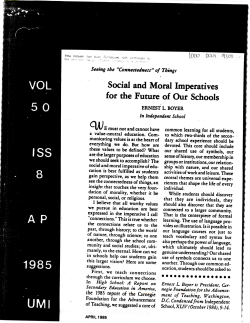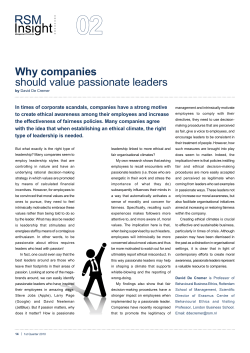
ISGPUC Scott Policy Position Paper
Technological Safeguards for the U.S. Food Supply: Moral and Ethical Dilemmas** H. Morgan Scott, D.V.M., Ph.D. Professor of Veterinary Pathobiology, Texas A&M University, College Station, Texas, U.S. Summary Safeguarding the American food supply through actions that improve food safety, security, and defense (FSSD) appears — at first glance — to be an objective without contention. True, there will always be priorities to be set, and trade-offs to be made, especially given limited and dwindling budgets. That said, the imperative to provide readily available food, at a reasonable cost, and free from pathogen and toxin contamination — whether intentional or unintentional — seems obvious. While technological solutions to FSSD problems abound, large-scale adoption and widespread diffusion of these often depends on ease of use, cost-benefit calculations, and effective marketing. Meanwhile, implementation decisions typically are made by the individuals or groups that bear the costs, even if that sector does not benefit directly from the technology. Conflicting moral obligations, combined with vague guidelines for ethical practice, can create untenable situations regarding adoption of new technology in agriculture and food, especially when readily apparent animal health, production, or welfare needs in the present are weighed against poorly characterized or future impacts on animal and human health and well-being. Antibiotics and beta-adrenergic agonists (BAA) used in United States animal agriculture are explored as exemplar technologies, with the potential to simultaneously safeguard the U.S. food supply while also posing temporally distinct risks to widely disparate parties. Science-based policy in this arena cannot shy away from exploring and seeking to understand the conflicting moral and ethical dilemmas that face multiple stakeholders, both present and future, and must seek to optimize effectiveness of these technologies for future generations through ethical practices in the present. Policy options for navigating this complex landscape must carefully be examined even as difficult and timely choices need to be made. Current realities Demographic predictions concerning human population growth as we head toward the year 2050, along with economic forecasts of massive shifts toward a growing middle class during the forthcoming 35 years, have led many to argue that future demands for a vastly expanded supply of animal-based protein warrant wider acceptance of controversial technologies in our food system. Examples of such technologies include growth promoting agents such as BAA in swine, turkeys, and cattle, genetically modified organisms (GMOs) of various kinds throughout agricultural production systems, growth hormones generated using recombinant DNA techniques, steroidal implants, and the routine use of antibiotics to promote growth and prevent disease. Moral and ethical considerations of these technologies are not simple, especially since potential risks and benefits seem unlikely to be borne by the same individuals or groups, and can take years or even decades to fully manifest. The various uses of antibiotics, from growth promotion through prevention, control, and treatment of bacterial disease, are well documented as to their benefits to animal health and well-being, though arguably less so in their potential to reduce risks related to food safety. The narrative that has emerged concerning the continued use of antibiotics in animal agriculture versus in human medicine tends to involve as much a discussion of moral beliefs or social norms as a discussion of science. Such a values-based approach to public deliberations and policy-making was wellillustrated in the precautionary principle-based approach used to enact a 2013 restrictive-use policy change in Europe concerning the use of colistin, an old antibiotic with little evidence of resistance, in animal agriculture. In June of 2010, Dr. Joshua Sharfstein, then U.S. Food and Drug Administration (FDA) deputy commissioner, suggested that antibiotics should be used only to protect the health of an animal and not for faster or more efficient growth. His quote during a conference call with reporters: "To preserve the effectiveness, we simply must use them as judiciously as possible.” Within this seemingly simple statement exists both the moral imperative to preserve effectiveness of antibiotics for the future, and the ethical framework by which such goals are to be achieved (i.e., avoid injudicious use in the present). The direct result of this statement was the rollout of two of the major policy initiatives of the FDA in the past 10 years: Guidance for Industry (GFI) 209 and 213, both of which are being implemented through 2016. In relatively few countries, BAAs may be fed to certain food-producing animals late in their production cycle to enhance growth, feed efficiency, meat protein, and carcass yield. Approval of BAAs for use in the U.S. is not without controversy, though federal regulators determined that benefits to producers outweighed risks for the food animals and that there exists minimal risks to human health. Since approval, reports have emerged that suggest there can be negative impacts of BAAs on animal health and well-being in certain situations. Policy decisions made under certain circumstances (e.g., where benefits to food security are weighted against documented animal welfare concerns in an ex post facto manner) are not well grounded in a regulatory sense. Further, they carry enormous consequences for commerce and affect a variety of interested parties. Since the summer of 2013, there has been a voluntary ban on sales of one BAA, zilpaterol, by its manufacturer and meat packers refuse to accept animals raised with the product. In this case, policy was set by downstream meat packer, retailer, and consumer expectations of animal welfare and supply chain accountability. Scientific opportunities and challenges In addition to human health and food security concerns, animal health and well-being also need to be considered in deliberations concerning research, development, commercialization, and adoption of technology. Many in the agrifood research and production community, including some Fortune 500 companies, argue that current public health, animal health, and welfare concerns must yield priority to the future needs of a growing population. In a January 19, 2015 New York Times investigation into animal welfare shortcomings at a U.S. Department of Agriculture (USDA) research facility, a recently retired scientist was quoted as saying, “It’s not a perfect world. We are trying to feed a population that is expanding very rapidly, to nine billion by 2050, and if we are going to feed that population, there are some trade-offs.” Clearly, the temporal scale of the risks and the benefits of many of these technologies test the limits of moral reasoning when it comes to defining our obligations to future individuals (i.e., the unborn and, in many cases, 2 to 3 generations removed from the present) and the proposed and expanded population numbers. Logic alone would suggest that if 7 billion or even 8.5 billion people lack sufficient resources to be fed, the population could not possibly multiply to reach 9 billion. Furthermore, arguments concerning the desirability of such a population size are completely lacking, implying an inevitability of the outcome. Regardless of these lapses in reasoning, the core question remains: Do we sacrifice tangible – if conflicted – moral obligations in the immediate present, in favor of a more nebulous obligation to unknown, unknowable, or even unconceived persons in the future? Further, how do we account or adjust for unforeseen risks and benefits in the present, even if not fully realized at the time a new technology is brought to market. These are among the grand challenges of our day; the next Green Revolution may instead be an animal protein revolution, if not a ‘Red Revolution,’ and the ethical litmus tests needed when applying new technology to sentient beings such as animals — rather than plants — greatly complicates the policy-making process. Policy issues Technologies displaying unique hallmarks of risk and benefit, as borne by different players in the food production system, must be subjected to rigorous assessments encompassing EMBARGOED—NOT FOR PUBLIC DISTRIBUTION Page 2 these multiple endpoints. Transparent dialog among sponsors, stakeholders (or their advocates in the case of animals), and regulators needs to occur to explicate the risk/benefit scenarios and inform the debate on the merits of approval. Policy, as developed and executed by regulatory agencies (including both the approval and post-approval process) needs to account more holistically for the intertwined nature of the food system and its actors and also for the unforeseen circumstances that cannot be uncovered in a pre-approval setting. As one example, although drugs are not metabolized as efficiently in sick as in healthy animals, pre-approval trials are almost always conducted using the latter. Residue-avoidance milk and slaughter-withholding periods established in these settings have been shown to be inadequate to protect public health. The ability of animals to physiologically adapt to endocrine agonists such as BAAs may not be adequate during periods of heat stress, nor is statistical power sufficient in small experiments to address the innumerable adverse endpoints that can emerge in a postapproval period. Formal post-approval surveillance systems must be developed, monitored, and overseen by independent parties (i.e., such as FDA or USDA), especially for products not developed to improve animal health or well-being. Quantitative risk assessment, the gold standard of regulatory approval, remains rigidly structured in linear systems. It defers to “hard sciences” even when technical solutions remain elusive and ignores human values even when problems demand their consideration. Instead, scenario-based risk assessments offer the potential for multiple stakeholders to more fully explore the breadth of known, and unknown, unknowns, even if resulting estimates appear to lack the rigor of a purely quantifiable and single endpoint. The major advantage of the more qualitative approaches exists in offering stakeholders the opportunity to mirror the multitude of potential outcomes against their own values and to engage in constructive debate with others, hopefully avoiding marginalization. Moral imperatives and accepted ethical practice must share the stage with the so-called hard sciences in determining the acceptability of novel technologies in the FSSD realm. When interested parties invoke implicit or explicit moral high ground, their worldviews need to be balanced against those views of others with equal stake in the process and the degree of scientific risk certainty. Acquisition of the most relevant data often begins the day that a new technology is first marketed. However, few formal mechanisms exist for capturing these data in a meaningful and systematic manner nor can re-evaluation of approval decisions occur without a very high threshold for proving harm or at great cost. A careful analysis of the post-approval process at regulatory agencies is warranted. Who speaks for the future? This question must immediately follow the question: Who speaks for those with no voice (i.e., the animals)? When developing technologies applied to sentient beings, we must aim to pass the litmus test of “do no harm” while they are under our care. Given the difficulty in achieving this completely, let alone measuring it, the focus of animal industries and food producers must be on constant vigilance, reevaluation, and independent oversight by third party auditors to assess well-being, minimize discomfort, and explore and adopt the best alternatives. ** A policy position paper prepared for presentation at the conference on Food Safety, Security, and Defense (FSSD): Safeguarding the American Food Supply, convened by the Institute on Science for Global Policy (ISGP), April 10 and 11, 2015, at Ursinus College, Collegeville, Pennsylvania, U.S. EMBARGOED—NOT FOR PUBLIC DISTRIBUTION Page 3
© Copyright 2025










